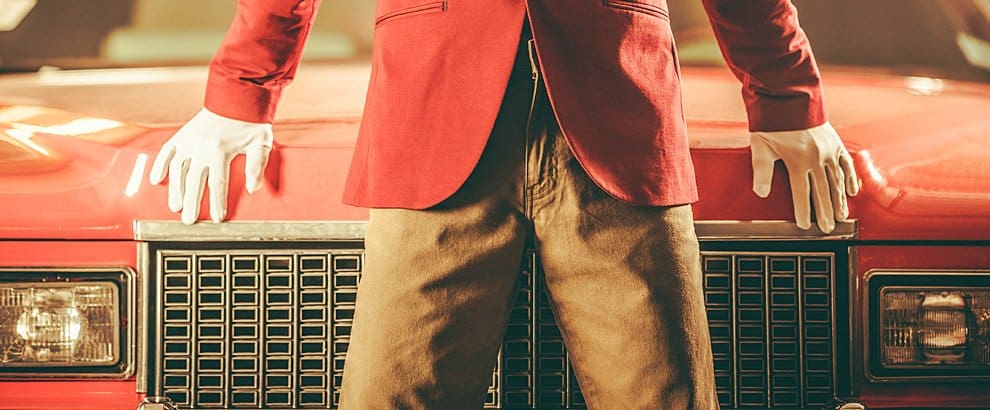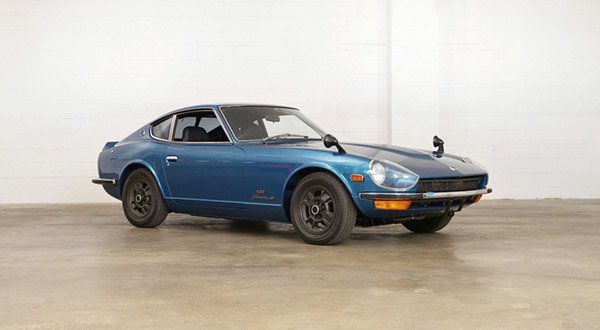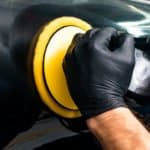Affiliate Disclosure: Some of the links in this post are affiliate links. As an Amazon Associate, we earn from qualifying purchases. Read more in our affiliate policy.

The Remarkable Keno Brothers And Their Famous Fine Automobile Auction
A Vehicle Auction Like No Other
On November 19, 2015, two brothers, Leigh and Leslie Keno conducted a historic auction of classic automobiles in New York City. The auctioneers treated every vehicle as a priceless Work of Art. The Rolling Sculpture Fine Automobile Auction and its distinctive marketing approach generated well over $8 million.

We seek to cover significant events that other sources sometimes overlook. For example, in the past, we’ve reported about the UK’s historical Wyedean Rally and Joseph “Million Mile Joe” LoCicero (1957-2016).
Now, almost five years later, we’ve decided to include the unique Rolling Sculpture Auction in our website’s Hall of Fame.
The Keno Brothers made an enduring contribution to auto enthusiasts by elevating Classic Cars to a status they genuinely deserve on auction sales floors around the world!
The exciting story of the Keno Brothers and their “Rolling Sculpture Auction” fascinates classic car collectors and fans to this day. It set a precedent for other auctioneers and auto sellers to follow.
Anyone who enjoys celebrating rare and one-of-a-kind vehicles won’t want to miss the opportunity to commemorate that classic car auction in the Big Apple. It inspires collectors to this day!
About The Keno Brothers
Born in Herkimer County, New York in March, 1957, the Keno twins both shared a love of historic auto preservation from an early age. Their parents operated an antique store. Their elder brother, Mitchell, also developed an interest in art preservation. Their father, Ronald Keno, specialized in restoring vintage vehicles. Leigh and Leslie Keno attended many antique shows as children.

Leigh Keno graduated with a BA in the History of Art from Hamilton College in Clinton, New York in 1979. The world-renowned Christie’s auction house in New York City hired him as an appraiser.
Leslie Keno graduated with honors from Williams College in Williamstown, Massachusetts in 1979. He accepted a position in New York City with the equally famous Sotheby’s auction house. He met his wife, Emily Becnel, who also worked in the antiquities field.

Both Leigh and Leslie Keno volunteered as furniture appraisers during the first season of Antiques Roadshow, and they appeared on the popular PBS series regularly (they both worked on the show in 2019).
In 1998, they participated in the Louis Vuitton China Run. The twins drove a classic vehicle, a 1938 SS 100 3.5 Liter Jaguar, on a road tour extending across some 1,000 miles. Both became actively involved in preserving vintage autos.
In 2005, President George Bush awarded Leigh and Leslie Keno the National Humanities Medal to recognize their contributions to the field of preservation.
The Keno brothers have served as judges for many years at the Pebble Beach Concours d’Elegance, an internationally prestigious collector car competition in California. They also co-authored a chapter in award-winning work, Stewardship of Historically Important Automobiles, published in 2013.
The brothers collaborated to host the Buried Treasure reality series. Fox broadcast episodes of the show during 2011. A few years later, the Keno twins and a business partner established an auction house, the Keno Brothers Fine Automobile Auctions.
It focused specifically upon auctioning collectible cars. The Rolling Sculpture Auction on November 19, 2015, served as the company’s major sales event.
Leigh and Leslie Keno drew upon their expertise in vintage car collecting in managing the historic auction in New York City.
The Keno Brothers’ Approach: Transparency & Attention to Detail
When they conducted the auto auction in 2015, Leigh and Leslie Keno garnered headlines by infusing the same high level of documentation and transparency into classic car sales that buyers expected in the realm of famous pieces of art.
The brothers already possessed a highly respected reputation in the auto preservation field, of course. Both had gained media attention for their work helping to conserve and restore vehicles of historic significance.

Leslie and Leigh Keno emphasized the importance of supplying an in-depth history and “provenance” for each auto.
This information assists fine auto collectors in evaluating the market value of a vehicle more accurately.
Additionally, since departments of motor vehicles in the United States (DMV) maintain extensive automotive records for registered vehicles, in some cases, customers enjoyed access to very precise and detailed automotive records of ownership (something which often requires challenging research in the case of fine art produced in the distant past).
The brothers maintained a website supplying detailed information about every vehicle included in the upcoming auction inventory. The site described the history and the ownership of each auto and furnished both a video of the auto and a detailed inspection report. The company also offered price comparisons and a market analysis report.
Leslie and Leigh Keno stressed the vital importance of transparency. In accordance with the tradition established for auto auctions in the USA, they offered prospective buyers opportunities to preview the merchandise.
Although for liability reasons most auction goers could not conduct test drives, prospective bidders did have an excellent opportunity to examine the vehicles and appreciate the unique aspects of each make and model.
Many of the people consigning autos for sale chose to include videos of their vehicles in operation.
A number of the auctioned autos had received attentive restoration on behalf of fine auto collectors.
To no one’s surprise, news of the auction generated considerable interest on the part of auto preservation enthusiasts.
The Rolling Sculpture Live Auction
The live auction took place on Thursday, November 19th at Starlight Clarkson Square in SoHo in New York City. The exhibit hall opened in advance on Wednesday, the 18th. It featured 40 rare vehicles for sale (offered in a total of 40 individual lots).
Every item presented for sale appeared on its own elevated platform, giving the commercial exhibit hall a strong resemblance to some auto museums. The marketing team displayed information about the vehicles on the walls in large, elegant script. They highlighted key selling points.
A total of 1500 bidders registered to attend the one-day event. The auction company provided every registered bidder with a tablet containing the full descriptions of the 40 lots. The files accurately displayed every vehicle.
The presentations included footage of each car’s performance over the road (when available). Numerous participants expressed their appreciation for the beauty of the display in the exhibit hall. Many people noticed strong parallels between the Rolling Sculpture Auction and an art auction.
Today, auto auctions frequently occur at a frenetic pace. In some cases, auctioneers seek to present a series of vehicles one at a time in rapid succession. Leigh and Leslie Keno made an effort to provide a less regimented setting.
They offered prospective buyers an opportunity to conduct previews without rushing to meet time deadlines. Even the auction itself would proceed at a more leisurely rate than the majority of automotive auctions in North America.
The Keno brothers and their business partner, Ken Sterne, also arranged for bidding to occur online during the auction. To provide this service, the trio joined with Proxibid, an online auction company co-founded by Joe Petsick.
Every year, Proxibid conducts approximately $2 billion in sales. The company conducts luxury auction sales over the Internet. The joint venture with Proxibid enabled interested bidders to submit bids remotely for vehicles sold at the Rolling Sculpture Auction.
The auction commenced in the evening, with auctioneer Simon Hope standing at the podium. According to Sports Car Digest, many registered bidders did not choose to attend the auction sale.
Ultimately, only 17 vehicles sold that evening. Three additional sales occurred after the auction ended. The total completed transactions for the event numbered 20 lots. Poor attendance or an unwillingness to meet the reserve price likely impacted the sales volume. Reportedly, none of the vehicles sold above the highest estimated value, and fully 45% sold for less than the lowest estimated price.
The Rolling Sculpture Auction earned high marks from participants for its attractive displays and its upscale sales environment. Many bidders praised the design and stylish appearance of the exhibition hall, and the effort the auction company made to draw attention to every lot.
By elevating every vehicle, the sponsors of the event emphasized the distinctive qualities of each car. The auction ultimately generated a total sales volume of $8,334,398. The vehicle commanding the highest sales price, a 1967 Bizzarrini Strada 5300, sold for $1,010,800.
Some Notable Classic Cars Presented And/or Sold at The Auction
Among the 20 beautiful autos offered at the auction, too many stand out to possibly describe all of them here. Seven of the most memorable include:
1969 Lamborghini Miura P400 S

Owned by the Historic Motor Car Investment Fund managed by Leigh and Leslie Keno, this lovely sports car sold at the auction for $974,400 (below its estimated highest value).
The manufacturer only produced 338 of the “S” models of the 1969 Lamborghini Miura P400. This one featured a colorful “Rosso Corsa” vibrant red paint coat and a wild boar’s hair “Senape” interior (one of only two units produced with that unusual cabin décor).
Experts considered this vehicle in “exceptional” condition at the time of the auction.
Founded in 1963 by the Italian industrialist Ferruccio Lamborghini, the Lamborghini automotive firm (now an Audi subsidiary) specializes in the design and manufacture of luxurious sports cars. The company, based in Italy, built engines for Formula One between the 1989 and 1993 racing seasons.
1929 Bugatti Type 40

Pierre de Brou and his wife used this classic two-seat roadster to participate in the 1930 Rallye d’Algers, traveling through portions of the rugged Algerian countryside. The couple then joined a caravan of three other similar Bugatti vehicles in making a roundtrip excursion across the Sahara Desert of North Africa.
The vehicle, built in 1929, possessed a customized commercial-style chassis. After returning to France, Mr. de Brou exchanged his Type 40 for a larger Type 44 model. The manufacturer replaced the commercial-style chassis with the current roadster chassis.
Now fully restored, its Black exterior paint contrasts with bright yellow wheels. During the intervening period of time prior to the auction, drivers used this vehicle to participate in a variety of competitive events and rallys.
This vehicle appeared in the 2003 International Bugatti Rally in California, the 2004 Le Mans Classic in France, and in many other events.
It sold at the Rolling Sculpture auction for $464,800.
1972 Nissan Fairlady Z432

Until 2000, Nissan manufactured its “Z-car” lines at a plant in Hiratsuka in Kanagawa, Japan. These attractive sports cars carried the Fairlady Z brand designation. They enjoy broad popularity in Japan, and continue in production there to this day (the abbreviation “JDM” refers to the Japanese Domestic Market).
This imported sports car from Japan sold at the auction for $170,800.
It belongs to a limited edition (Nissan produced only 420 similar units for the Japanese market). It offers a stylish teal Blue exterior and Black interior trim. JDM Magazine reportedly selected this vehicle to display on its cover, in fact. The auto underwent restoration shortly after the turn of the century.
The owner modified its radiator and supplied an air conditioning system. The restoration utilized original authentic parts and retained the original factory trim colors.
1965 Aston Martin DB5

At the auction, this historic vehicle commanded one of the highest selling prices, $950,000. While well below the upper estimated value of $1.6 million, the price does indicate the interest of many buyers in the Aston Martin brands. The use of Aston Martin vehicles in a series of James Bond films helped spur demand for this brand.
The 1965 Aston Martin DB5 offered at the auction displayed a Black Pearl exterior and leather seats trimmed in red. Following a restoration in 1990, auto collector Kurt DeBene modified the trim colors, selecting tan leather seating and a stylish Sage Green exterior paint. The vehicle carried a registration with the Aston Martin Owners Club.
Its rarity stems from two facts: the manufacturer produced only 886 DB5 models, and this particular unit displays a left-hand steering wheel (as opposed to the standard right-hand steering wheel used on most UK roadways).
British businessman, Lionel Martin, and auto engineer, Robert Bamford, founded the Aston Martin firm in 1913 in London. Lionel Martin enjoyed racing motor cars at Aston Hill. The two business partners had originally formed a company called “Bamford & Martin” to market Singer Motors Limited vehicles.
However, they decided to design and manufacture their own lines of vehicles under the Aston Martin brand. The company they founded underwent several reorganizations but became well known internationally for manufacturing racing vehicles by the early 1930s.
1973 Porsche 911 S

The Porsche AG firm maintains its headquarters in Germany. Automotive engineer Ferdinand Porsche initially founded the company as a consulting firm in 1931. During the 1950s and 1960s, Porsche AG became known internationally for manufacturing superbly engineered lines of sports cars.
It produced the first Porsche 911 in 1963. The brand has continued in production since that date. The company developed the 911 S as a high-performance vehicle. Beginning with the 1974 model year, significant changes occurred in the 911 S design, resulting in increased horsepower.
At the auction, participants bid on the 17th 1973 Porche 911 S ever manufactured. Imported to the United States the same year, this lovely Silver sports car boasted a Black-trimmed interior and black “bumperettes” (a small bumper designed to maintain the bumpers in better condition during collisions).
It remained in service in Kansas for more than 20 years and changed ownership several times. In 2009, Phil Bagley from Klub Sport performed a complete restoration of the vehicle.
This Porsche 911 S commanded an auction sales price of $201,600.
1969 Ferrari 365 GTB4 N.A.R.T. Daytona Coupe

Estimate: between $4,900,000 – $5,900,000
No one attending the auction succeeded in purchasing this amazing vehicle, a Rosso Chiaro colored sports car with a Black interior. Driven by Luigi Chinetti, Jr. and co-driver Bob Grossman, it placed 5th overall at the prestigious Le Mans 1971 24 Hour French Classic.
Mr. Grossman purchased the vehicle later in 1971, but sold it again a short time later. The original engine block sustained a crack during competition; an owner replaced it in 1993 with one constructed to Series 3 specifications by Grand Touring Cars, Inc. of Scottsdale, Arizona.
A private collector made both the original block and the sports car available for sale at the time of the auction in New York.
The Italian auto racer and entrepreneur Enzo Ferrari (1898-1988) founded Ferrari N.V. in Modena, Italy. The company acquired an acclaimed reputation for designing and manufacturing superb lines of high-performance vehicles.
Enzo Ferrari established the Scuderia Ferrari Grand Prix team to compete in motor races, and his keen interest in competitive auto racing contributed to the sports car development process.
1967 Bizzarrini Strada 5300

This rare vehicle commanded the highest selling price at the auction, $1,010,800 USD.
The Italian test driver and automotive engineer Giotto Bizzarini, a designer of vehicles for Alfa Romeo and later Ferrari, developed this high-performance race car with the assistance of Pietro Drogo.
Unfortunately, the factory lost records concerning the number of models produced, so the exact number of similar vehicles remains unknown.
Manufactured in mid-October, 1968, and first registered for use in Padua, Italy, this one displays an eye-catching dark Blue exterior and Tan cabin trim. During the 1970s, the stuntman Carey Loftin (1914-1997) owned this vehicle. It changed hands several times. This 1967 Bizzarrini Strada 5300 underwent restoration in 2009 in California.
Rolling Sculpture – A Historic Event
The Rolling Sculpture Live Auction presented classic cars in an elegant, refined setting. Prospective bidders enjoyed a remarkable opportunity to explore the history and condition of every vehicle offered for sale.
Leigh and Leslie Keno used their expertise in the fields of antiques and appraising to assist collectors in evaluating some of the rarest and most distinctive vehicles on the market at that time. Although not every model sold at the auction, the event generated a total of just over $8.3 million.
It showcased the extent to which vintage auto buyers participate in a significant (and rapidly developing) segment of the auto industry!
Other Articles Worth Reading :
Disclaimers
All product names, logos, and brands are property of their respective owners. All company, product and service names used in this website are for identification purposes only. Use of these names, logos, and brands does not imply endorsement.
It is our policy to make every effort to respect the copyrights of outside parties. If you believe that your copyright has been misused, please provide us with a message stating your position and we will endeavor to correct any misuse immediately.
Some of the links in this post are affiliate links. As an Amazon Associate, we earn from qualifying purchases. This means if you click on the link and purchase the item, we may receive an affiliate commission, at no extra cost to you. This helps us keep this website alive. Read more in our affiliate policy.







